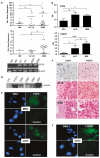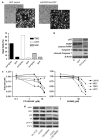FGF5 as an oncogenic factor in human glioblastoma multiforme: autocrine and paracrine activities
- PMID: 18362893
- PMCID: PMC2879862
- DOI: 10.1038/onc.2008.61
FGF5 as an oncogenic factor in human glioblastoma multiforme: autocrine and paracrine activities
Abstract
Fibroblast growth factor 5 (FGF5) is widely expressed in embryonic but scarcely in adult tissues. Here we report simultaneous overexpression of FGF5 and its predominant high-affinity receptor (FGFR1 IIIc) in astrocytic brain tumour specimens (N=49) and cell cultures (N=49). The levels of both ligand and receptor increased with enhanced malignancy in vivo and in vitro. Furthermore, secreted FGF5 protein was generally present in the supernatants of glioblastoma (GBM) cells. siRNA-mediated FGF5 downmodulation reduced moderately but significantly GBM cell proliferation while recombinant FGF5 (rFGF5) increased this parameter preferentially in cell lines with low endogenous expression levels. Apoptosis induction by prolonged serum starvation was significantly prevented by rFGF5. Moreover, tumour cell migration was distinctly stimulated by rFGF5 but attenuated by FGF5 siRNA. Blockade of FGFR1-mediated signals by pharmacological FGFR inhibitors or a dominant-negative FGFR1 IIIc protein inhibited GBM cell proliferation and/or induced apoptotic cell death. Moreover, rFGF5 and supernatants of highly FGF5-positive GBM cell lines specifically stimulated proliferation, migration and tube formation of human umbilical vein endothelial cells. In summary, we demonstrate for the first time that FGF5 contributes to the malignant progression of human astrocytic brain tumours by both autocrine and paracrine effects.
Figures





Similar articles
-
Inhibition of CXCL12/CXCR4 autocrine/paracrine loop reduces viability of human glioblastoma stem-like cells affecting self-renewal activity.Toxicology. 2013 Dec 15;314(2-3):209-20. doi: 10.1016/j.tox.2013.10.003. Epub 2013 Oct 21. Toxicology. 2013. PMID: 24157575
-
Loss of endothelial programmed cell death 10 activates glioblastoma cells and promotes tumor growth.Neuro Oncol. 2016 Apr;18(4):538-48. doi: 10.1093/neuonc/nov155. Epub 2015 Aug 8. Neuro Oncol. 2016. PMID: 26254477 Free PMC article.
-
Both autocrine and paracrine effects of transfected acidic fibroblast growth factor are involved in the estrogen-independent and antiestrogen-resistant growth of MCF-7 breast cancer cells.Cancer Res. 1998 Jan 15;58(2):352-61. Cancer Res. 1998. PMID: 9443417
-
The 18 kDa isoform of basic fibroblast growth factor is sufficient to stimulate human melanoma growth and angiogenesis.Melanoma Res. 2007 Jun;17(3):155-68. doi: 10.1097/CMR.0b013e328184451e. Melanoma Res. 2007. PMID: 17505261
-
FGF5 promotes osteosarcoma cells proliferation via activating MAPK signaling pathway.Cancer Manag Res. 2019 Jul 10;11:6457-6466. doi: 10.2147/CMAR.S200234. eCollection 2019. Cancer Manag Res. 2019. PMID: 31372048 Free PMC article.
Cited by
-
Research progress of fibroblast growth factor in nervous system diseases.Zhejiang Da Xue Xue Bao Yi Xue Ban. 2022 Dec 25;51(6):738-749. doi: 10.3724/zdxbyxb-2022-0180. Zhejiang Da Xue Xue Bao Yi Xue Ban. 2022. PMID: 36915973 Free PMC article. English.
-
The role of fibroblast growth factors in tumor growth.Curr Cancer Drug Targets. 2009 Aug;9(5):639-51. doi: 10.2174/156800909789057006. Epub 2009 Aug 1. Curr Cancer Drug Targets. 2009. PMID: 19508171 Free PMC article. Review.
-
Neural cell 3D microtissue formation is marked by cytokines' up-regulation.PLoS One. 2011;6(10):e26821. doi: 10.1371/journal.pone.0026821. Epub 2011 Oct 28. PLoS One. 2011. PMID: 22046371 Free PMC article.
-
FGF5 is expressed in melanoma and enhances malignancy in vitro and in vivo.Oncotarget. 2017 Sep 23;8(50):87750-87762. doi: 10.18632/oncotarget.21184. eCollection 2017 Oct 20. Oncotarget. 2017. PMID: 29152117 Free PMC article.
-
Role of Fibroblast Growth Factors Receptors (FGFRs) in Brain Tumors, Focus on Astrocytoma and Glioblastoma.Cancers (Basel). 2020 Dec 18;12(12):3825. doi: 10.3390/cancers12123825. Cancers (Basel). 2020. PMID: 33352931 Free PMC article. Review.
References
-
- Antoine M, Wirz W, Tag CG, Mavituna M, Emans N, Korff T, et al. Expression pattern of fibroblast growth factors (FGFs), their receptors and antagonists in primary endothelial cells and vascular smooth muscle cells. Growth Factors. 2005;23:87–95. - PubMed
-
- Berger W, Setinek U, Hollaus P, Zidek T, Steiner E, Elbling L, et al. Multidrug resistance markers P-glycoprotein, multidrug resistance protein 1, and lung resistance protein in non-small cell lung cancer: prognostic implications. J Cancer Res Clin Oncol. 2005;131:355–363. - PubMed
-
- Berger W, Setinek U, Mohr T, Kindas-Mugge I, Vetterlein M, Dekan G, et al. Evidence for a role of FGF-2 and FGF receptors in the proliferation of non-small cell lung cancer cells. Int J Cancer. 1999;83:415–423. - PubMed
-
- Brachner A, Sasgary S, Pirker C, Rodgarkia C, Mikula M, Mikulits W, et al. Telomerase- and alternative telomere lengthening-independent telomere stabilization in a metastasis-derived human non-small cell lung cancer cell line: effect of ectopic hTERT. Cancer Res. 2006;66:3584–3592. - PubMed
Publication types
MeSH terms
Substances
Grants and funding
LinkOut - more resources
Full Text Sources
Medical
Miscellaneous

